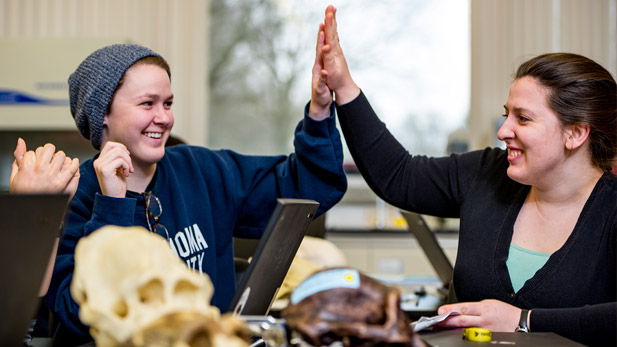Rendezvous with Greatness: 25 Years of Co-Education

In 25 years, Rose-Hulman women have excelled – taking campus leadership roles, earning top academic and athletic awards, and blazing new trails as alumni.
When the first female students arrived on campus in the fall of 1995, they opened the door to a new level of excellence that even Rose-Hulman hadn’t yet achieved.
“I believe that Rose-Hulman is headed for a rendezvous with greatness,” said then-president Sam Hulbert soon after the Board of Trustees voted to admit women in October 1991.
The four-year delay between the board vote and the first coed freshman class allowed male students who signed up for an all-male college experience to graduate. It also allowed faculty and staff to lay the groundwork for a smooth transition.
“My early years at Rose-Hulman were filled with workshops and seminars designed to help faculty and staff…learn to interact with female students,” recalls chemistry professor Luanne Tilstra, who joined the institute in 1992. Faculty started by asking “What’s the best way to teach engineering to females,” but ended up asking, “What’s the best way to teach engineering, period,” she says. “I believe the most significant outcome of transitioning to a co-educational institution is that Rose became exceptional at continuous improvement in the way we teach engineering.”
The first coed freshman class included more than 90 women comprising roughly 7% of the total student body. The number of females and their impact on campus has grown steadily ever since. Today, the 474 women on campus comprise about 24% of the student population at Rose-Hulman. (Nationally, women comprise 23.8 percent of undergraduates in engineering programs). Yet, in the past five years, female students at Rose have won two-thirds of the Herman Moench and John T. Royse awards at Commencement – two of the institute’s highest honors. Female alumni have also distinguished themselves as leaders in engineering, business, health care, government, academics, and virtually every other field.
For some women in the first coed class, the historic nature of their arrival in 1995 was overshadowed by the ordinary excitement and challenge of a freshman year.
“Obviously, when we got there, there were a lot of news cameras,” recalls Kendra Basler, one of the first female students and a 1999 mechanical engineering alumna who now owns an engineering regulatory affairs consultancy. “I think that it certainly was registering that this was not quite the normal college experience for most people. For me, I was just focused on getting a degree. I had to take that seriously and couldn’t get too distracted by anything else.”
Sara Ayres, another 1999 mechanical engineering alumna, remembers some obvious signs that having women on campus was new to upperclassmen during her freshman year. Some guys complained they had to start showering before classes, for example. On the other hand, she notes with pride that Rose-Hulman achieved its first-ever No. 1 ranking from U.S. News & World Report the year she and the rest of the inaugural class graduated, 1999. The institute has maintained that No. 1 ranking ever since.
Since 1995, opportunities for women have grown along with their numbers. The Rose-Hulman chapter of the Society for Women Engineers (SWE) was chartered in the spring of 1996 and was soon hosting guest speakers and events for area high school girls with an interest in science, engineering or mathematics. Today, Rose-Hulman’s SWE chapter is one of the fastest-growing in the nation, earning the SWE Membership Growth Award for 2021. It is currently publishing YouTube videos on a wide variety of engineering topics.
“One of the coolest things about being in the first class of women was the opportunity to start new clubs and organizations from scratch,” says Kim Henthorn, a 1999 chemical engineering alumna and associate professor and incoming head of the Department of Chemical Engineering at Rose-Hulman. Among other things, the first women on campus launched two sororities, the SWE chapter, and numerous athletic teams from the ground up, she notes.
“It was a lot of work, but it was so rewarding, especially now. I can see how all of these groups have evolved over the last 25 years, and it makes me proud that I was a part of some of that.”
“I’m thankful every day that I got a chance to go to Rose-Hulman,” says Erin Gawron-Hyla, a 1999 mathematics and chemistry graduate who is now an entrepreneur and a chemist for the U.S. Army Research Laboratory. “I could go to anyone on campus and get any help I needed. Just having that atmosphere of Rose-Hulman and the supportive nature of everything is so different [from a larger state school] and I am so grateful that I had a chance to be a part of that.”
Looking back after 25 years, it’s clear the women of the Class of 1999 blazed a trail for future women to follow. And their success alleviated any doubts that females could flourish at Rose-Hulman.
“I don’t want anyone to think that we as women got special treatment for being in that first class,” says Sara Zembrodt, a 1999 chemical engineering alumna and currently the director of new product-eCOA for THREAD, a clinical trial platform “The expectations were still very, very high, as they should be for every student who attends. But I am very proud to say that we were able to help establish that pathway for coeducation and that it works. I would hope that our participation in those early classes helped pave the way for the continued success that Rose-Hulman has had.”